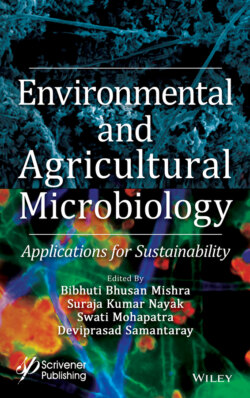Читать книгу Environmental and Agricultural Microbiology - Группа авторов - Страница 63
3.5.2 Bioleaching
ОглавлениеIn bioleaching, metal cations are mobilized from almost insoluble ores by complexation and biological oxidation method. The application of microorganisms for recovery of heavy metals is currently a universal enhanced biotechnological method [68]. This technique is mainly accepted by mining industries in order to extract metals incorporate in low-grade sulfide ores. In this method, solid remains are discarded as waste material, while metals are transformed to solution phase. Presently, bioleaching method is used in several metal removal applications from ground water, sludge, soil, and sediments [69]. The biomining is a universal word for two techniques such as bioleaching and bio-oxidation techniques. There are two types of leaching method such as contact and non-contact. In non-contact leaching method, metals are mainly removed via planktonic bacteria that oxidize the surface mineral ions in solution. The Fe3+ ions arise from the bacteria and interact with the surface of mineral, where they decreased and oxidized the moiety of sulfide and release the Fe2+. So, again Fe2+ ions pass into the cycle to continue the reaction again. In contact leaching method, the maximum cells adhere to the surface of sulfide minerals. This is an electrochemical method in which the suspension of sulfide minerals occur between the borders of bacterial cell and the sulfide mineral surface and this area is occupied by EPS [68].
The EPS plays an important role in this bioleaching process through an interfacial method, which takes place in natural environment. During the process of up-taking of heavy metal (Fe3+) ions, uronic acids facilitate to produce exopolymers among cell wall and surface of metal sulfide. These complexes involved in electrostatic interaction to form primary attachment, oxidizing attacks to deterioration of metal sulfide and act as nutrient [70] (Figure 3.3). The chemo-lithotrophic bacteria such as Acidothiobacillus sp., Leptosperillium sp., and archaea are involved in metal recovery from sulfide minerals. These bacteria are gram negative, aerobic, and able to survive below pH 3.0 and temperature 25°C–35°C. Leaching bacteria are mostly belongs to proteobacteria (Acidithiobacillus sp., Acidiphilium sp., Acidiferrobacter sp., and Ferrovum sp.), Nitrospirae (Leptospirillum sp.), Firmicutes (Alicyclobacillus sp. and Sulfobacillus sp.), and Actinobacteria (Ferrimicrobium sp., Acidimicrobium sp., and Ferrithrix sp.) [68, 69]. But among all bioleaching bacteria, Thiobacillus sp. involved in solubilization of metal sulfide because it takes carbon dioxide from atmosphere for cellular synthesis, pulls their energy from oxidation of elemental sulfur, reduces sulfur compounds, and results in production of ferric ions and sulfuric acids, which are entangled in heavy metal extraction. The frequently used bacteria for bioleaching process are Acidothiobacillus thiooxidans, Acidothiobacillus ferrooxidans, and Leptospirillum ferrooxidans, and these are able to grow in high acidic condition (pH 1.5–3.0) [69].
Figure 3.3 Mechanism of bioleaching.
The oxidation of metal sulfide by Fe/S oxidizing bacteria is defined through two distinct pathways such as polysulfide and thiosulfate pathway [68, 69]. These mechanisms depend on metal sulfide reactivity with protons (acid solubility) [69]. In case of thiosulfate pathway, metals are acid-insoluble such as pyrite (FeS2), molybdenite (MoS2), and tungstenite (WS2), and Fe3+ ions occur through metal sulfide extraction. This reaction results the production of metal cations (M+) and thiosulfate that oxidizes to sulfuric acid. The production of sulfuric acid creates acidic condition so T. ferrooxidans and L. ferroxidans catalyze Fe3+ ions for recycling. In case of polysulfide pathway, metals are acid soluble such as sphalerite (ZnS), galena (PbS), arsenopyrite (FeAsS), chalcopyrite (CuFeS2), and hauerite (MnS2) through electron extraction by iron(III) ions and proton attack. In this mechanism, polysulfide is the main intermediate form and can be oxidized to sulfuric acid by using bacteria A. ferroxidans and A. thiooxidans [71]. In bioleaching process, maintenance of acidic condition is essential because the optimum action of Fe/S oxidizing bacteria and to retain metals constant in solution phase.
